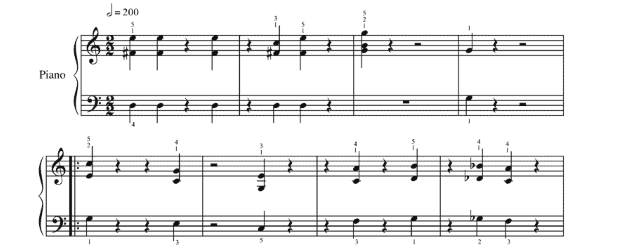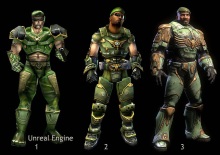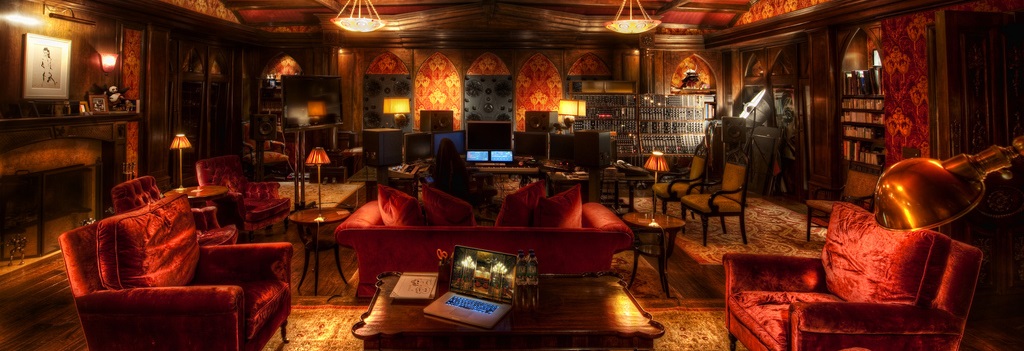
Advances in audio technology and the hardware to drive it powered the latest evolution of soundtracks early in the early years of the new millennium. High fidelity, CD-quality, studio-recorded, surround sound music became the norm and the line between gaming and cinema grew ever more blurred. But as we know, the old-school never really dies…
So here we are. Beepers, MIDI, MOD, square waves and pulse-width modulation are out and hi-fi is in.
Start Your Engines
 In part 4 we touched on the Unreal Engine. Since those early days the Unreal Engine has gone through several iterations and Epic are currently wowing the industry with their latest version across PCs, consoles and even mobile platforms. Along with advances in graphics, physics, networking, pipelining, scripting, resource management and animation, audio has some a long way too. Though not as far as you might think. These days, computers are more than powerful enough to stream and decode high bitrate MP3s without breaking a sweat – even full surround sound isn’t a challenge any more. We’ve gone from a few bleeps at the opening credits to a 5.1 recording of an orchestra. So what exactly is there for an engine to do?
In part 4 we touched on the Unreal Engine. Since those early days the Unreal Engine has gone through several iterations and Epic are currently wowing the industry with their latest version across PCs, consoles and even mobile platforms. Along with advances in graphics, physics, networking, pipelining, scripting, resource management and animation, audio has some a long way too. Though not as far as you might think. These days, computers are more than powerful enough to stream and decode high bitrate MP3s without breaking a sweat – even full surround sound isn’t a challenge any more. We’ve gone from a few bleeps at the opening credits to a 5.1 recording of an orchestra. So what exactly is there for an engine to do?
As we learned, iMUSE was excellent at blending and manipulating MIDI tracks to match the music up with the events on screen, but this is far harder to do with digital recordings. So what does a modern game engine bring to the music table? Let’s take a look at some highlights of the Source Engine:
- Surround Sound. Support for stereo, headphone, 4 channel and 5.1 surround mixes.
- Real-time Wave File Stitching. A simple scripting system lets audio designers build aggregate effects out of wave sequences.
- Overall Mix Control. Audio designers can build several overall mixes using scripts and the game can dynamically switch between those mixes to get different fader settings for action vs. dialog scenes.
- Scripting System for Environmental Sounds. VAudio designer can script custom ambient loops, random events, and DSP effects that are triggered based on the player’s position in space. This can also be modified by game logic for dynamic effects.
The Source Engine is of course Valve’s baby, and came careening onto the world stage in 2004 with Counter Strike: Source shortly followed by the spectacularly successful Half-Life 2. Like Doom and Quake before it, Half-Life 2 redefined what a first person shooter could and should be, a masterfully designed game tightly weaving a linear story into a seemingly open world. By never pulling the view away from the perspective of Gordon Freeman, and by never having the good doctor speak, Valve allowed their players to absorb the game world and the story, to experience it, and then – in superbly balanced and scripted sequences – to violently impact it. The immersion was due, in part, to the talented composer Kelly Bailey. He had already worked with Valve on the first Half-Life, and knew exactly what he was doing. Subscribing solidly to the school of through that says that just as an a viewer should never notice a cut, nor should she notice the music. For the most part the music is ambient, atmospheric and quiet. It enhances the mood and adds to the environment, and in many cases feels like part of the environment.
With one exception.
Everyone who’s played Half-Life 2 knows what I mean. You cross a line, a harsh voice calls out, a gun fires and the music starts. The rules go out the window then, the music comes front and centre, grabs the player by the neck and shouts “Play!”
(The magic happens at about 6:50) This, incidentally, is part of the wonderful SoldierHawk blind Let’s Play, well worth watching even without the music. For a later example, with less commentary and fewer screams of “Die Die Die!”, see how the track LG Orbifold fits into the gameplay so flawlessly.
Valve and Bailey know exactly when and how to use music to drive the gaming experience, and just as importantly, when to let it take a back seat so the player can immerse themselves. Half-Life 2 is a rare game in many ways, not least because it so effortlessly uses music in a game that is both player-driven and heavily scripted.
A Wild Composer Appears
In terms of of effort, attention and resources being thrown at soundtracks these days, with AAA game studios having budgets of tens of millions and striving for the perfect cinematic experience, it was only a matter of time. Hans Zimmer, Oscar-winning legend, composer of music for The Lion King, Gladiator, Inception, Black Hawk Down and countless others, arrived on the gaming scene in 2009 when he composed the main theme to Call of Duty: Modern Warfare 2. Lorne Balfe composed the bulk of the score, but the main theme was all Hans Zimmer. In 2011 he would return to provide the theme for Crysis 2 – again with Balfe providing the remainder of the music.
With films as diverse as Cool Runnings and The Dark Knight Rises under his belt, Hans Zimmer is obviously talented enough to wrangle a wide range of sounds and genres, and the two tracks above demonstrate that he is more than able to bring that to the gaming table. Both games are military hero-fests, reflected in the music, but they have different tones nonetheless and the music echoes that perfectly.
Bringing such a heavyweight on board shows how far studios have come in recognising that soundtracks are a vital part of the gaming experience, especially as they push ever more towards true immersion and cinematic gameplay. By that measure, game music has reached an apex, but not every developer or studio has that end-goal in mind. Some, and I cannot stress how much I love them for it, are outright retro.
Everything Old Is New Again
The very first soundtrack I linked to on this site was for the 2010 sensation VVVVVV. 2010. Released between Modern Warfare 2 and Crysis 2, but it would be hard to imagine a more opposite set of musical styles. The chiptune genre is alive and well – not through necessity as even a relatively old smartphone is capable of storing and playing back high fidelity music, but out of love for the genre and the sound.
It isn’t just music getting the nostalgic love either. Games are still being released that hark back to a childhood decades past. In 2011 Robit Studios released Treasure Adventure Game. There’ll be a full review appearing on this site in time, but for now GOG.com says it best:
Treasure Adventure Game was created by Stephen Orlando. He spent over 2 years of his life developing it. When you see the scope and detail in this game, it’s hard to believe that it was created by just one guy.
It’s true, the game is a pixel-perfect piece of nostalgia. It isn’t what games were like, it’s what we remember them being like. It’s colourful, detailed, charming and engrossing and the 16-bit soundtrack (again – higher quality than the games of yore, but it’s somehow exactly like we remember) by Robert Ellis suits it wonderfully adding a sense of mystery, exploration and adventure to the game, even – occasionally – that sense of child-like wonder that games held for us when the medium was new and unexplored.
Going back to GOG.com for a minute, pay attention:
The music changes with the environments and day-night cycles, enhancing the feel the game is evoking and making you feel immersed in the world as you travel through it.
So many game studios simply don’t seem to realise how little things like that can have such an effect on immersion. We’ve evolved to have a diurnal cycle, of course day and night will be different. They should look different, behave differently and sound different.
[…and oh my goodness. I’m listening to the soundtrack as I write this and I just heard the cut between tracks 13 and 14. Brilliance. Right, now I have to get to that part of the game.]
So… Where Next?
If this post seem shorter than the others, that’s because it is. I could write thousands of words on any number of soundtracks from the past ten years and PC and Xbox 360, and no doubt I will, week by week, but in the context of tracking the evolution of video game music over the last thirty years what more is there for me to say? We’ve come from single-channel beepers that couldn’t even drive sound during gameplay to surround-sound orchestral pieces written by Oscar winning composers, while simultaneously coming full circle and going right back to the chiptune age.
That isn’t to say game soundtracks have nowhere else to go. Of course not. Amazingly talented composers are turning out new music to go with new games every day, pushing the limits of hardware and genius. And there will be technological advancements too. Truly dynamic music, music written by machines, music as gameplay, gameplay as music, to name just a few. When the Spectrum came out, could anyone have predicted Rock Band? Crysis? Metroid Metal? Perhaps they did. And perhaps right now someone has the germ of an idea that will be setting the stage for the state of the art for video game music in 2043. It may be my child. It may be yours. In an age where some of the founding fathers of the industry are still forces to be reckoned with and age is truly no barrier, it may be you. All I know is that I’m going to enjoy listening to the journey there. In 8-bit.

